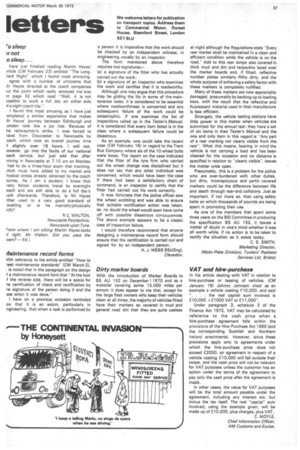Dirty marker boards
Page 37

If you've noticed an error in this article please click here to report it so we can fix it.
With the introduction of Marker Boards to BS AU 152 on December 11970 and as a motorist covering some 15,000 miles per annum it does appear to me that, except for the large fleet owners who keep their vehicles clean at all times, the majority of vehicles fitted have their markers so covered in mud and general road dirt that they are quite useless at night although the Regulations state "Every rear marker shall be maintained in a clean and efficient condition while the vehicle is on the road." Add to this rear lamps also covered in thick mud and dirt and tarpaulins laced over the marker boards and, if fitted, reflective number plates similarly filthy dirty, and the whole purpose of achieving a safety factor with these markers is completely nullified.
Many of these markers are now appreciably damaged, presumably by backing up to loading bays, with the result that the reflective and fluorescent material used in their manufacture is less efficient.
Strangely, the vehicle testing stations have little power in this matter when vehicles are submitted for the annual test: they have a set of six items in their Tester's Manual and the one and only item in this regard is "Any part of a rear marking not clearly visible from the rear". What this means, bearing in mind the vehicle is not carrying a load and has been cleaned for the occasion and no distance is specified in relation to "clearly visible", leaves the matter wide open.
Presumably, this is a problem for the police who are over-burdened with other duties, but dirty, inconspicuous and partly covered markers could be the difference between life and death through rear-end collisions. Just as important, if not more so, than using safety belts on which thousands of pounds are being spent in promoting their use.
As one of the members that spent some three years on the BSI Committee in producing the specification BS AU 152, it leaves a matter of doubt in one's mind whether it was all worth while, if no action is to be taken to rectify the situation as it exists today.
C. S. SMITH. Marketing Director, (Moto-Plate Division), Tuckers' Radiator Services Ltd, Bristol










































































































